Nearly every new 9mm pistol has the slide cut for an optic. While an optic-ready slide is the natural progression for new striker-fire pistols, older platforms are also being adapted to accept a red dot. Take, for instance, the Beretta Model 92 series, a classic double-stack 9mm, which is now available in an optic-ready variant, or the 1911 platform, which is now more frequently being adapted to carry a red dot. Some manufacturers have morphed the platform to accept double-stack magazines, literally doubling the round count in 9mm guns, and called them 2011s. An excellent representation of the diversity in double-stack 9mm pistols that are optic-ready is seen in the Beretta 92X Performance Carry Optic, Springfield Armory Prodigy 4.25, Walther PDP Full Size 4.5, and Glock’s G47 MOS.
We would take any one of these guns in a New York minute, but it would be a tough decision if we had to choose just one. On one hand, there is the simplicity of a striker-fire pistol like the Walther or the Glock, or the crisp 1911-style trigger of the Springfield, or the versatility of the Beretta’s double-action/single-action trigger. Perhaps a heavier gun to help stifle recoil, or a lighter gun for more comfortable concealed carry is the better option? Those were some of the questions we asked when evaluating these excellent pistols, as well as the usual parameters of performance, reliability, accuracy, and ease of use.
Because these are all optic-ready pistols, we tested four different red dot reflex sights on them. The optics were judged on clarity of the red dot, size of the red dot, brightness adjustment, ease of battery maintenance, ability to co-witness with iron sights, ease of use, and ruggedness. Yes, we dropped expensive pistols with expensive red dots in the dirt so you don’t have to. We also used the red-dot sight as impromptu cocking levers with our hands, on the edge of a shooting bench, and the mouth of a Kydex holster. Front slide serrations are important when a red dot is mounted on these pistols because the optic gets in the way of a traditional pinch-style slide rack where your support hand palms the top of the slide and you pinch the slide between your thumb and index finger to pull back the slide.
The four red-dot sights were an Ameriglo Haven Carry Ready Combo, $329; a Crimson Trace CTS-1250, $230; Steiner’s MPS, $499; and Trijicon’s RMR Type 2, $479. We ranked each pistol on its own merits separate from the red dots. Accordingly, the heights and weights for the handguns don’t reflect the presence of the red dots. But we did pair each gun with a single dot sight for extensive action and accuracy shooting. The red dots offered enough extra precision off the bench that we reported only the accuracy data with each sight aboard. The red-dot grades are listed in the same modules as the pistols they were primarily used on.
How We Tested
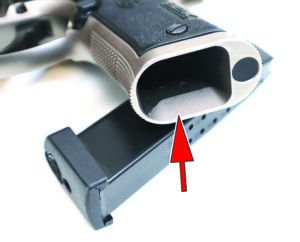
We tested the guns/red dots for speed on plain cardboard IPSC/USPSA targets (78 cents each from shop.actiontarget.com) performing the Failure Drill or Mozambique Drill, depending on how politically correct you are. Red dots make aiming much easier than aligning traditional sights, but finding the red dot can be liability, especially in bright light conditions. All the more reason to install co-witnessed iron sights. For accuracy testing at 25 yards, we used Thompson Targets TAC (Training with Audible Cue) targets ($8 per five-pack from ThompsonTarget.com). These targets can be used with a partner who cues the shooter on what part of the target to fire at. The idea with TAC targets is to train the shooter to process commands and make decisions quickly. Scores can be calculated so you can chart your progress and train smart or have bragging rights for the day.
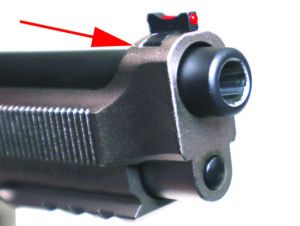
We used both training ammo and defense ammo, with different bullet weights and types. Training rounds consisted of Winchester Active Duty and Federal American Eagle, both loaded with 115-grain FMJ bullets. Defense loads included Remington HTP with 147-grain JHP bullets and SIG V-Crown with 124-grain JHPs. After tabulating the range data, we discovered the Walther had the highest muzzle velocities and the Beretta the lowest, with an average difference of 58 fps. The Springfield and Glock had muzzle velocities in between the two. We also found more differences. For one thing, the triggers on all four were very different, but one gun stood out as our favorite. Here’s what we thought about each gun in more detail.
BERETTA 92X PERFORMANCE CARRY OPTIC J92XPCO21 9MM LUGER
$1749
GUN TESTS GRADE: A
RED DOT SIGHT: STEINER MPS 8700-MP
$499
GUN TESTS GRADE: A-
The Beretta 92 series is a capable, reliable, and inherently accurate pistol due to the short-recoil design. The barrel doesn’t tilt during recoil, it stays in place. The M9, a variant of the 92FS, became our nation’s service sidearm in 1985 and still is used today, but it was phased out in 2017, when it was replaced by the SIG M17 and M18.
| Action Type | Semi-auto, open slide, short-recoil delayed locking-block system |
| Trigger Type | DA/SA |
| Overall Length | 8.7 in. |
| Overall Height | 5.8 in. |
| Maximum Width | 1.6 in. |
| Weight Unloaded | 47.6 oz. |
| Weight Loaded | 54.0 oz. |
| Barrel Length/Twist | 4.9 in.; 1:10 |
| Capacity | 15+1 |
| Slide | Nistan, steel |
| Slide Retraction Effort | 14.0 lbs. |
| Frame | Nistan, steel |
| Frame Front Strap Height | 2.2 in. |
| Frame Back Strap Height | 3.3 in. |
| Grips | Textured polymer |
| Grip Thickness Maximum* | 1.3 in. |
| Grip Circumference Maximum* | 5.5 in. |
| Front Sight | Fiber optic |
| Rear Sight | Adjustable |
| Trigger Pull Weight Double Action | 6.5 lbs. |
| Trigger Pull Weight Single Action | 4.4 lbs. |
| Trigger Span Double Action | 3.1 in. |
| Trigger Span Single Action | 2.7 in. |
| Magazines | (2) double stack; steel w/polymer base pads |
| Safeties | Firing-pin block; thumb lever |
| Warranty | 1 year |
| Telephone | (800) Beretta |
| Website | Beretta.com |
| Made In | Italy |
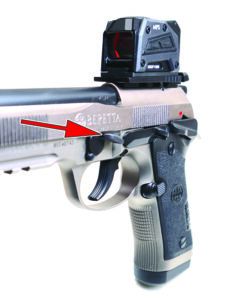
There have been numerous variants of the basic Model 92 — 92S, 92FS, 92D, 92G, Vertec, 90Two, M9, M9A3, Elite LTT — to name a few. The 92X Performance Optics Carry is the latest evolution of the famed pistol and, in our opinion, enhances the pistol, as well as fixes some of its imperfections, such as the slide-mounted safety, minimal slide serrations, and grip girth. Beretta has positioned this pistol for competition shooting, where we think it will excel in the right hands. We also think this would make a refined EDC pistol with the proper holster and belt.
The new trigger, which Beretta calls the Xtreme-S Trigger, is galaxies away from the standard 92 series trigger. The new trigger is fully adjustable by the user for take-up, break, and overtravel. In our opinion, it is a very good trigger, even for those who shun double-action-to-single-action triggers. The double-action trigger press broke on average at 6.5 pounds, and the single action press broke at 3.1 pounds. Reset is short and positive. The trigger is serrated, and the skeletonized hammer is lighter than the standard hammer for more speed.
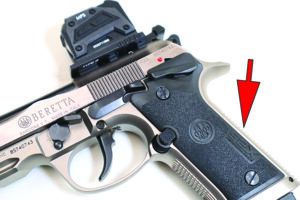
In the luggage-style case are two magazines, a magazine loader, back strap module, and Toni optic system. The frame has a matte-stainless-steel-looking finish Beretta calls Nistan that contrasts nicely with the black barrel and controls. It is smart looking.
The steel frame of the 92X is Vertec style with a flat back strap that allows users with smaller hands to shoot the pistol more comfortably. The back-strap module mimics the original 92FS/M9 frame size. Testing was conducted without the backstrap module. Front and rear grip straps are coarsely checked and provide plenty of gripping real estate. The frame has an elongated beavertail to reduce hammer bite, and the rear of the trigger guard is undercut so you can get a slightly higher grip. The trigger guard is also rounded in lieu of the standard squared-off style. A flared magwell permits smooth reloads. An accessory rail is built into the dust cover. The ambi safety is mounted on the frame, not the slide, so there is no chance of accidentally flicking the safety on when racking the slide. The thumb safety works positively when flicked with the thumb of the shooting hand. Some of the other controls are tweaked, too. The take-down lever projects out more than the standard lever, making a great gas pedal or index point for a user’s support-hand thumb. Also, the magazine-release button sticks out more than usual, so your thumb hits it more easily when dumping an empty magazine. The slide release protrudes just enough to make it functional without getting in the way.
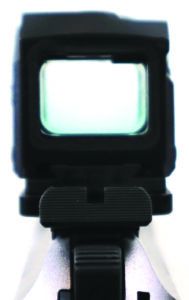
The 92X is equipped with a Brigadier heavy-profile slide and sports slide serrations forward and aft so manipulating the slide or doing a press check is easy. It also makes the 92X hefty. Weight unloaded is 47.6 ounces, and that extra weight makes this 92 variant a flat shooter.
Iron sights consist of a red-fiber-optic front sight and fully adjustable notch rear with the back side of the rear sight serrated to reduce glare. The most notable enhancement to the slide is the cut for optics. The Toni plate system is compatible with nearly all red dots. For our shooting, we chose a Steiner MPS (Micro Pistol Sight) reflex red dot sight. The MPS is different from the other red dots tested because it looks like a little black box with the laser dot emitter completely enclosed. Also different is it mounts to the optic plate via a tiny clamp so it sits slightly higher than the other optics. It’s equipped with a 3.3-minute-of-angle (moa) red-dot reticle that is crisp with no optical flaring and offers eight easy-to-choose brightness levels of adjustment. The battery compartment can be accessed at the top of the box without removing the optic from the gun. We used the optic as a lever to rack the slide and found the MPS to be rugged and well built. Elevation and windage direction is clearly marked and can be adjusted using the rim of a 9mm case. Two buttons on the left-hand side illuminate the dot and adjust brightness. The Steiner sight automatically shuts off after 13 hours to conserve battery juice. Users need to turn on the sight to use it. We would not use this sight on an EDC pistol because it needs to be turned before aiming. As a competition and target shooting sight, it offers a wide field of view and a crisp pinpoint dot.
Going hot on Failure Drills, the 92X was easy to shoot, putting two fast shots to center of mass and the third shot in the cranium area of the paper. The double-action trigger pull is smooth, so you can stack the trigger and then press through for the shot when on target. Reset is short, and the transition to single action is natural. The pistol was easy to control due to the weight and grip. It cycled smoothly, and felt recoil was soft. The pistol is easy to control, even at the upper edge of the shooter’s pace. With the Winchester Active Duty training ammo, the best group measured 1.4 inches. The best group with the Federal American Eagle practice ammo was 1.48 inches. The smallest group with the defense ammo was 1.94 inches and 2.1 inches for the SIG and Remington, respectively. Across all ammo selections, groups ranged an honest 2 inches on average. There were no issues with the pistol.
Our Team Said: We found ourselves wanting to shoot the Beretta more. We liked the smooth double-action trigger pull, but we really liked the single-action trigger pull. The pistol is heavy, and that heft helps manages recoil. This pistol is for the user who wants a refined pistol for competition or concealed carry, and the latter if you’re willing to tolerate the weight.
The Steiner MPS offers a wide field of view and a crisp dot, but we feel it is best suited for competition or target shooting instead of everyday carry because the shooter needs to turn on the red dot prior to use.
9mm Luger Range Data
To collect accuracy data, we fired five-shot groups from a bench using a rest. Distance: 25 yards with the reflex red dot sights. We recorded velocities using a ProChrono digital chronograph set 15 feet from the muzzles.| Federal American Eagle 115-grain FMJ | Beretta 92X | Glock G47 MOS | Springfield Armory Prodigy 4.25 | Walther PDP 4.5 |
| Average Velocity | 1135 fps | 1136 fps | 1140 fps | 1150 fps |
| Muzzle Energy | 329 ft.-lbs. | 330 ft.-lbs. | 332 ft.-lbs. | 338 ft.-lbs. |
| Smallest Group | 1.48 in. | 1.68 in. | 0.70 in. | 1.76 in. |
| Average Group | 1.59 in. | 1.88 in. | 1.02 in. | 1.98 in. |
| Winchester Active Duty 115-grain Ball | Beretta 92X | Glock G47 MOS | Springfield Armory Prodigy 4.25 | Walther PDP 4.5 |
| Average Velocity | 1220 fps | 1257 fps | 1229 fps | 1289 fps |
| Muzzle Energy | 380 ft.-lbs. | 404 ft.-lbs. | 386 ft.-lbs. | 424 ft.-lbs. |
| Smallest Group | 1.40 in. | 1.49 in. | 1.02 in. | 1.39 in. |
| Average Group | 1.44 in. | 1.54 in. | 1.06 in. | 1.45 in. |
| SIG V-Crown 124-grain JHP | Beretta 92X | Glock G47 MOS | Springfield Armory Prodigy 4.25 | Walther PDP 4.5 |
| Average Velocity | 1023 fps | 1051 fps | 1031 fps | 1116 fps |
| Muzzle Energy | 288 ft.-lbs. | 304 ft.-lbs. | 293 ft.-lbs. | 343 ft.-lbs. |
| Smallest Group | 2.10 in. | 2.04 in. | 0.97 in. | 1.56 in. |
| Average Group | 2.30 in. | 2.72 in. | 1.20 in. | 1.78 in. |
| Remington HTP 147-grain JHP | Beretta 92X | Glock G47 MOS | Springfield Armory Prodigy 4.25 | Walther PDP 4.5 |
| Average Velocity | 921 fps | 920 fps | 925 fps | 976 fps |
| Muzzle Energy | 277 ft.-lbs. | 276 ft.-lbs. | 279 ft.-lbs. | 311 ft.-lbs. |
| Smallest Group | 1.94 in. | 2.09 in. | 1.10 in. | 1.12 in. |
| Average Group | 1.97 in. | 2.38 in. | 1.27 in. | 1.26 in. |


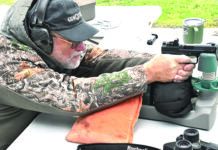
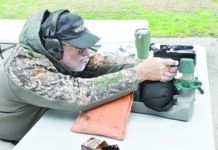
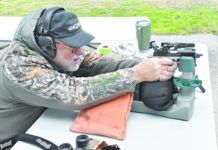
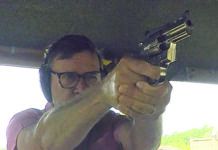
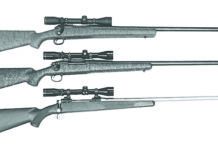
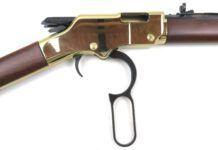

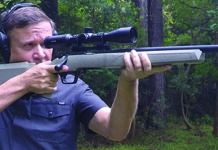








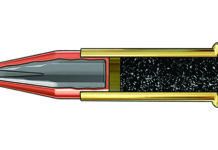
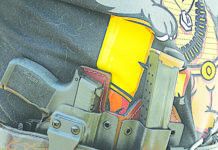






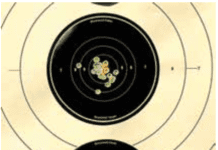
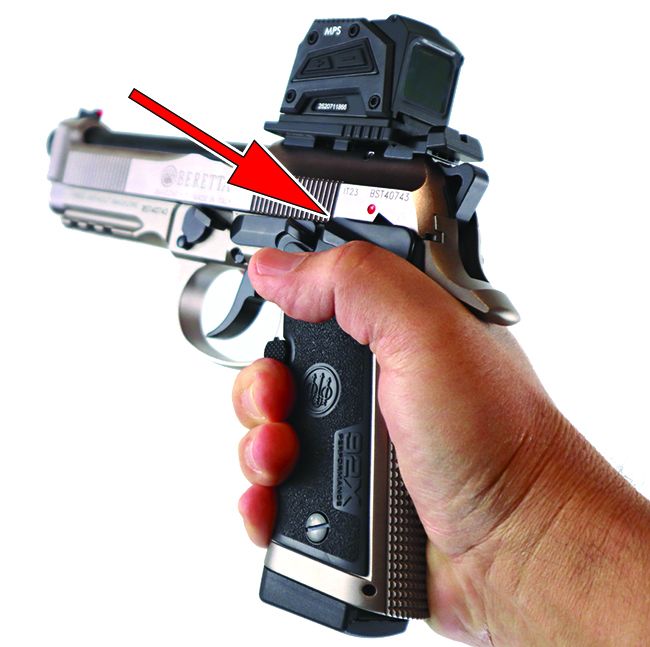

Nice write up. If I was going to use the Steiner MPS as a carry optic I’d just turn it on first and leave it on until I didn’t need it. Battery usage wise, it would be no different than a motion activated dot. The dot is still on because you are always moving.